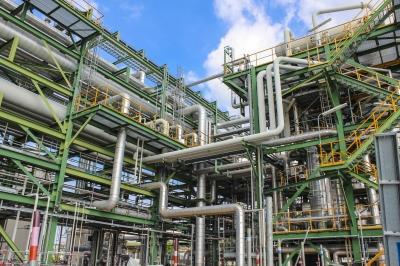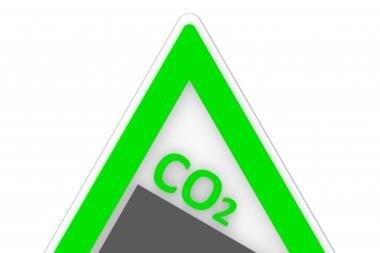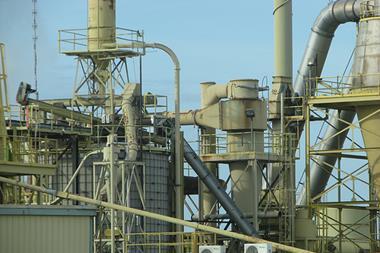The US’s growing self-sufficiency in oil and gas is adding to environmental and climatic risks to create a volatile energy sector, yet the risks are manageable

The global energy marketplace is one of the most dynamic industrial sectors. Oil and gas fuel growth and fluctuations in price and availability send ripples that reach every corner of our world.
Competition for hydrocarbon resources is fierce, and growth in Asian economies – particularly India and China – has led to booming demand, and booming prices.
These rising prices have created the investment conditions for unconventional production techniques, such as hydraulic fracking, and they have pushed energy firms into new territories, including the Arctic.
US power
These new directions are already bringing dramatic changes. A few years ago, the US was a net importer of hydrocarbon energy, yet now, thanks to fracking (see box) it will soon become a net exporter – reforging the economic and geopolitical balance between Washington DC and the Middle East in the process.
It has also rewritten the risk profile for investors in neighbouring countries.
In recent years, Canada has led the way in using new technology to extract oil from so-called ‘tar sands’, and its Athabasca sands contain huge reserves of bitumen – possibly as much as 1.7 trillion barrels, comparable to the total proven reserves of conventional petroleum.
Canadian tar sands
But the rapid growth of the sector – oil and gas is currently the largest contributor to Canadian GDP – faces a challenge from the south as the US, its largest customer, powers up its own production at such an astonishing rate. This is inevitably leading to fluctuations in demand and market uncertainty.
The Canadian tar sands illustrate the changing risk profile of the oil and gas sector in other ways. Research by EY has identified that, in addition to rising US production and sky-high capital investment costs, Canada faces problems with market access and infrastructure constraints.
There are significant signs of cost inflation that create long-term concerns for investors, and the rapidly increasing scale of project activity is hampered by a shortage of workers with the right skills.
Environmental concerns
In addition, like fracking and Arctic oil exploration, exploiting the tar sands raises environmental concerns and firms face public relations problems that affect acceptance of new projects: all of which exposes them to the risk of reputational damage.
This was illustrated earlier this year when six Greenpeace activists climbed Britain’s tallest building, The Shard in London, to protest against Shell’s activities in the Arctic, and in the process grabbed sustained media attention from around the world and focused public debate on the firm’s plans.
Similarly, the large protests at the Cuadrilla test oil drilling site in west Sussex forced a firm that few outside the sector had heard of before this summer to defend its brand in the harsh glare of media attention – or risk becoming a household name for all the wrong reasons.
History of controversy
In some ways, none of this is new territory for energy firms. They have negotiated controversy, protest and public debate for decades – and dealt with the fall-out from major environmental catastrophes, such as Deepwater Horizon.
“In any risk management study, you often find that the biggest threat to a businesses is damage to its reputation,” says Marsh energy practice leader for Europe, the Middle East and Africa Andrew Herring.
“I don’t think that the unconventional oil and gas side of the business will affect that. You look at the [Deepwater Horizon] event; that is a traditional event, a blow-out, albeit offshore, and that is as damaging as anything.”
When it comes to transferring some of this risk, insurance for the energy sector has several aspects.Market conditions are generally relatively soft.
Safe haven
“We seem to be in an extended period of stability as investors continue to regard our industry as a safe haven from the turmoil of the overall global economy,” says Willis Global Energy chief executive AJC River.
This is particularly true on the offshore side, “where there has been a very low frequency of loss and underwriters have got very profitable portfolios”, says Herring.
“We’ve seen a lot of new capacity coming into the market from new players, and existing players increasing their potential participation in dollar terms.”
However, there is a sharp distinction between the upstream and downstream sectors. Although both are stable – experiencing good capacity driven by modest losses – and for now there is none of the volatility of recent years, things could change rapidly in the downstream sector.
Hurricane claims
Claims as a result of 2012’s Hurricane Sandy have spooked some underwriters and analysts believe that one or two significant players could leave the market, prompting others to follow – something that would create a rapid hardening.
“Although as yet there have been no major market withdrawals, another poor loss year in 2013 will surely cause some insurers to think seriously about a change of underwriting strategy,” says River.
The upstream sector, meanwhile, is in great shape. According to analysis by Willis, the market has been consistently profitable, and “history suggests that alternative leadership competition for such profitable business usually emerges in one form or another”.
But this has yet to materialise, and until it does – and competition intensifies – any softening is likely to be fairly moderate.
FRACKING
The US is experiencing a revolution in energy production that could be as significant as the first discovery of oil in the country in 1859.
Owing to the controversial process known as fracking, the US is set to become a net energy exporter in the next few years and could, by 2017, overtake Saudi Arabia and Russia to become the world’s largest oil producer, according to the International Energy Agency.
The technique, which involves injecting a mix of high-pressure steam and chemicals into shale rocks deep underground to unlock trapped gas and sometimes oil, is proving to be a game-changer.
Within a few short years the US has become independent in natural gas and will soon become independent in oil, with increases in production running at an astonishing 15%-20% a year.
More than €95bn ($125bn) has been invested since 2005 by the 50 largest US oil and gas companies, according to a study by EY.
DEEPWATER HORIZON
The Deepwater Horizon blow-out is widely believed to be the largest marine oil spill in the history of the oil industry – an event that has so far cost operator BP upwards of €32bn ($42bn).
Following an explosion on the Deepwater Horizon rig on 20 April 2010, and its subsequent sinking, a sea-floor oil gusher spewed out an estimated 4.9 million barrels of crude into the Gulf of Mexico before it was finally capped on 15 July.
The clean-up costs, compensation payments and legal ramifications have hammered BP. In November 2012, BP pleaded guilty to 11 counts of manslaughter, two misdemeanours and a felony for lying to the US Congress.
The firm was also temporarily banned from new contracts with the US government, and agreed to pay an eye-watering €3.4bn ($4.525bn) in fines and other payments – and legal proceedings are still ongoing.
INNOVATION
“In a relatively competitive environment insurers are always looking for ways to steal a march on their rivals,” says Marsh’s Andrew Herring. “But I’ve not seen anything radically innovative coming out of the market at the moment.
“One of the big areas where we would like to see something new is cyber cover for first-party property damage and business interruption. But we need to see much more significant limits than anyone is prepared to offer.
“We see a lot of appetite from clients to have this risk covered. But insurers are often reluctant to get involved because they don’t feel like they understand the risk well enough at the moment.”
Some in the energy sector argue that change is slow because both brokers and energy insurers are heavily dominated by the London market, and that the British insurance industry is very conservative.
“Brokers are not developing,” says Norwegian oil and gas giant Statoil ASA vice-president, head of insurance Trygve Imsland. “They are being developed by market demand. [But] I do believe we will start to see different products on high excess level linked to finite solutions – both with, and without, risk transfer – being launched and maybe also becoming competitive to traditional insurance.”
Global view
Some international brokers argue that taking a truly global view – that takes in all options, even the unconventional – is the best way to meet their clients’ needs.
Herring says: “[London] has been in a position whereby they haven’t felt a significant threat to their dominance, and hence the need to be creative. But I think that’s changing.
“It’s important for us to continue to work to make ourselves relevant to clients. The captives of some energy firms have become more and more significant, so the risk transfer element of what we do has become less important.”
Equally, Herring sees a broadening in the scope of the services insurers can offer.
“Energy companies have to go further and further afield to find the oil and the gas, so a business like Marsh, with a global network, can offer them real support – for example, in making sure that they are compliant with local regulations on insurance,” he says.
“We always think that to be relevant and add value for our clients, we like to offer alternatives. Whether that’s alternative products or alternative markets, that remains our focus.”
Marsh operates through 12 energy hubs around the world and each of those is able to market regional capacity, says Herring. “We are seeing an increasing role for regional cover, in the Middle East, Asia – particularly Singapore – and Latin America.
“That’s the one way we have been able to apply pressure on the traditional oil and gas market and provide more competitive terms for clients. We are a firm believer that the quota share capacity that has been talked about a lot recently has significant client value. Especially by bringing new capacity into the market. It drives competition.”
LIABILITY
Liability is one area of risk transfer where geography is key. “Third-party liability is completely different depending on where you are in the world,” says Marsh’s Andrew Herring.
“For international liability outside the US, there is plenty of capacity, new players coming into the market and a very competitive environment leading to significant reductions in cost.
“But in the US there is a shortage of capacity and demand is going up all the time, meaning that prices continue to rise.”
There are still only a handful of carriers prepared to write primary general liability for US energy risks. If you have a good claims history and positive attributes, then you may have choice and competitive quotations. If not, your options are severely limited.
Even clients with good ratings may find that underwriters use widely differing models for upstream, midstream – including pipeline and processing – and downstream risks – refining, oil delivery, and renewable energy.
“There is very limited capacity in some specific areas, such as pipelines,” says Herring. “There is a new law in Canada that will force pipeline companies to buy a billion dollars of insurance, which increases demand on limited supply.
“Underwriters will be able to get all the income they want without having to compete for business. On the North American side it will remain a very tough market. On the international side it’s completely different, we haven’t seen significant losses and it’s viewed as a very profitable class.”
PROPERTY
Oil and gas extraction is a high-tech, high-cost business and capital investment in new projects is already huge and rising as climbing commodity costs encourage firms to move into tougher and tougher environments, requiring more and more complex infrastructure.
Unfortunately for the industry, so far underwriters cannot keep pace. “Lack of coverage occurs more and more in terms of the installations being worth more than the market can provide,” says Statoil ASA’s Imsland.
“Market capacity may be in the region of €2bn-€3bn ($3bn-$4bn). New construction of a floating liquefied natural gas unit can cost €5bn-€6bn ($6bn-$10bn), plus potential loss of production income if an incident occurs. And the cost of this is rising faster than the increase in market capacity.”
In this environment firms need to be creative in their approach to risk.
“While the standard risk transfer product is a very competitive and effective way of covering a lot of risk, for the bigger corporates, when we can only offer cover of a few billion, you have to ask ‘is that really meaningful?’,” says Marsh’s Herring. “BP has suffered losses stretching into tens of billions in the Gulf of Mexico.
“I think there is an appetite out there for a more meaningful, contingent capital product or similar, rather than pure risk transfer to the limitations we are able to offer at the moment.
“We have a number of dialogues going with a number of major energy companies trying to effect cover in that area, but it’s early days.”
Imsland says: “I see that the big players – Berkshire Hathaway, Swiss Re, AIG – are providing coverage facilities to selected brokers, where they offer higher limits. This could be for traditional coverage as well as for finite products.
“There is an ongoing process to create sufficient coverage for catastrophic losses, like the Macondo blow-out in the Gulf of Mexico.
“Government wants higher limits, especially in the US and EU, and small energy companies seem to favour an energy sector solution, whereby they can have a choice to free ride on the back of the majors. Insurers can always do more.”
CLAIMS
Where insurance really matters is when it comes to claims, and here the sector seems to be on top of the process – even if clients can suggest improvements.
“I think the biggest concern around claims is the time it takes to settle,” says Marsh’s Herring. “The market has shown that it can be very responsive on claims, but there is a problem in our business that there is seldom anything we can regard as a ‘straightforward’ claim.
“There are always issues and nuances around every event. But I think more could be done to speed up the process.”
Firms in the sector remain positive. “My experience is that claims which are clearly within the terms of an insurance policy will be paid in good faith and within reasonable time,” says Statoil’s Trygve Imsland.
“However, claiming for a platform that was not built according to industry norm, and cracks apart due to normal weather conditions, will not – and should not – be paid for. The market seems to be liquid and in control of aggregated exposures.”




















No comments yet